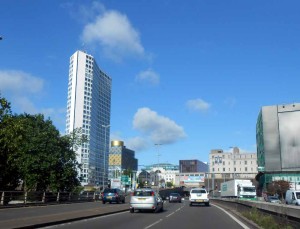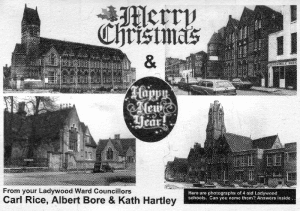Alan Clawley spots a confusing, yet festive, dichotomy.
We all have to cope with the loss of the familiar but we can adopt various strategies for dealing with it.
Longing for the return of a golden era may be sheer nostalgia but, in the case of the Romantics such as Pugin and Morris, it can result in action to turn the clock back and make buildings and artefacts like they did in the Middle Ages.
Romanticism springs from a deep dislike of the present – with its mechanisation and mass markets. More seriously, people who feel the loss of national identity, even a spurious one, have been known to resort to violence to recover it. A more acceptable activity can be seen around in the many railway canal and building preservation societies run by enthusiastic volunteers.
Its impossible to judge from the Christmas card recently delivered to Ladywood residents by Councillors Bore, Hartley and Rice, how they react to the loss of Victorian school buildings in their ward. Their card clearly wants to remind people of the past. The seasonal greetings are set in old-fashioned Gothic script, and four schools are illustrated only one of which still stands today. Readers are challenged to guess their names – hard for the younger generation but easier for older residents who may even recall being a pupil or in one of the schools. We don’t know if the pictures stir sad or happy memories. Neither do we know what the councillors or their constituents feel about the modern schools that replaced them.
One strategy is to accept that a particular loss is ‘inevitable’. This may be literally true in the case of people reaching a ‘good age’. Buildings can decay too but this is seldom fatal as even a humble garden shed can be kept going for centuries given sufficient loving care. Post-war ‘pre-fab’ houses were expected to last 25 years but often outlived the ’permanent’ houses that were meant to replace them.
In the modern era progress is said to be inevitable but its only after a building has been lost that those who knew it can judge if progress has really been made. Those in authority tend to cite the need for progress to get their own way with a population that won’t wake up until it is too late. But finding that a loss wasn’t inevitable will make people more sceptical next time.
 Which takes us to a second strategy, one that denies that a ‘loss’ is a loss at all; a psychological trick favoured by authoritarians and ideologues. Herbert Manzoni denied that any building more than 15 years old was worth keeping. This fitted neatly with his philosophy that people living in ‘old’ housing must be given an entirely new world, one designed by him and which would turn them into new citizens. Many years after his death we still live with his legacy in the council estates of Highgate, Nechells and Ladywood.
Which takes us to a second strategy, one that denies that a ‘loss’ is a loss at all; a psychological trick favoured by authoritarians and ideologues. Herbert Manzoni denied that any building more than 15 years old was worth keeping. This fitted neatly with his philosophy that people living in ‘old’ housing must be given an entirely new world, one designed by him and which would turn them into new citizens. Many years after his death we still live with his legacy in the council estates of Highgate, Nechells and Ladywood.
HRH Prince Charles denied the architectural worth of the Central Library in 1989 when he said it was more like a place where books are burned rather than read. Clive Dutton carried on the process when he advised Cabinet that it had ‘no architectural merit’ when more informed people said clearly that it did. In this way officers, councillors and the public were given permission to put aside any doubts about destroying a good building before its time.
At the extreme end of the denial strategy is dehumanisation, which enables those in authority and their followers to justify genocide to a compliant and gullible population.
But let’s not read too much into a Christmas card – Happy Christmas! to Sir Albert and colleagues.




Yes.